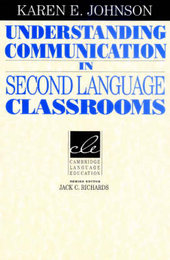
|
Understanding Communication in Second Language Classrooms
Paperback / softback
Main Details
| Title |
Understanding Communication in Second Language Classrooms
|
| Authors and Contributors |
By (author) Karen E. Johnson
|
| Series | Cambridge Language Education |
|---|
| Physical Properties |
| Format:Paperback / softback | | Pages:204 | | Dimensions(mm): Height 229,Width 153 |
|
| ISBN/Barcode |
9780521459686
|
| Classifications | Dewey:418.007 |
|---|
| Audience | |
|---|
| Illustrations |
1 Line drawings, unspecified
|
|
Publishing Details |
| Publisher |
Cambridge University Press
|
| Imprint |
Cambridge University Press
|
| Publication Date |
24 February 1995 |
| Publication Country |
United Kingdom
|
Description
The author constructs a conceptual framework that clarifies patterns of classroom communication. The paperback edition offers an integrated view of communication in second language classrooms - one that acknowledges the importance of what teachers and students bring to the class environment, as well as what actually occurs during face-to-face communication within the classroom. Drawing on actual classroom transcripts from a range of instructional settings, Johnson constructs a conceptual framework through which teachers can recognize how patterns of classroom communication are established and maintained, how these patterns affect students' participation in classroom events, and how their participation shapes the ways they use language for learning and their opportunities for second language acquisition. Relevant research is presented from the areas of classroom discourse, language in communities, teacher cognition, classroom learning, and second language acquisition.
Reviews'The major strength of this book is in its real examples of how second language classroom communication is established and maintained facilitating teaching, learning and second languge acquisition. It is a valuable reference for teacher educators, student teachers and classroom teachers.' VATME Newsletter, No 63, 1996 'The book both does what it sets out to do and does it well. It is reader-friendly, the plentiful examples and clear explanations both contributing to this quality.' EA Journal, Vol 13, No 2
|